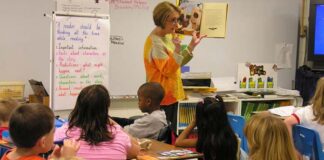Many people have welcomed Julia Gillard’s plan to boost funding to public schools. But the scale of the money continuing to go to private schools ensures an already drastically unequal funding system will remain entrenched.
According to education experts like David Zyngier, Australia has probably the highest proportion of students in private schools in the entire developed world. Nearly 40 per cent of school students are in the private system, compared to an average of 17 per cent across the OECD group of nations.
Julia Gillard’s funding plan does offer a real increase in funding to government schools, of $12.1 billion over six years, including state government contributions.
But the details are less impressive. The plan provides much less than the amount recommended by the Gonski review. The total funding over the next six years is only half of the $39 billion required to fully fund Gonski’s recommendations. The funding is also “back-loaded”, with very little money available in the early years.
What is clear is the scale of the concessions to private schools. Gonski proposed a funding model based on providing a base level of funding for each student and targeted top up funding for students from poorer backgrounds, for Aboriginal students and students with a disability.
Gonski recommended this extra funding be directed to the most disadvantaged 25 per cent of students. But Gillard has watered this down to spread the money over the bottom 50 per cent. This will ensure that many private schools will have access to the extra funds. All this means that the funding pool is spread more thinly, and less of the money will get to where it is most needed.
Private schools
Enormous government subsidies to private schools were at the heart of the Gonski review from the beginning. And Gillard has guaranteed that every single private school, no matter how wealthy, will receive a funding increase. This is on top of the funding boost they received from the Howard government as a result of its ideological obsession with undermining public education.
Already private schools receive more federal government funding than universities; $36 billion between 2009 and 2013. The decision to boost their funding again means they will be able to maintain their advantage over government schools in terms of teaching resources. This will see the drift from the public education system continue.
Research by Barbara Preston for the Australian Education Union shows that the proportion of low-income students at government schools doubled in past 25 years. It found 75 per cent of students in government schools were from low-income families compared to 27 per cent in Catholic schools and 24 per cent in independent private schools.
In addition 85 per cent of indigenous students and 78 per cent of students with funded disabilities attend government schools.
The middle class and the well off have increasingly opted out of the public system, draining resources from government schools, which are left to educate the most disadvantaged and marginalised.
Conditions
In exchange for the extra funding the states must also sign up to Gillard’s national plan for school improvement, which entrenches the regressive standardised testing regime, NAPLAN. An extra test will even be introduced, in science.
This testing regime distorts the school curriculum and degrades learning by forcing teachers to teach to the test in an effort to boost school ratings. Still more information will be put on the government’s MySchool league table to publicly compare each school’s NAPLAN results.
The government claims MySchool gives parents information to make an informed “choice” about which school is best for their kids. But its real effect is to deepen the educational divide as middle class families move their children out of “under-performing” schools, creating pockets of entrenched disadvantage.
The focus on test scores will be reinforced by giving principals more power over budgets and staffing, which in turn will depend on their school’s ranking in the education market.
Tragically, teachers’ unions, state and federal, have uncritically embraced Gonski (and now, Gillard’s version) in the hope that it might boost funding to public education. Similarly, they now also accept NAPLAN, allowing the market to eat away at public education.
The Labor government is hoping to be able to campaign in the federal election as the party of education by stitching up agreements with the state governments. But the Liberal state governments have savagely attacked public education (see Victorian teacher’s story). So will Abbott.
Gonski won’t save public education—that will still take a fight by the education unions and parents demanding extra funding, and opposing NAPLAN, MySchool, and the continuing hand-outs to the private schools.
By James Supple





